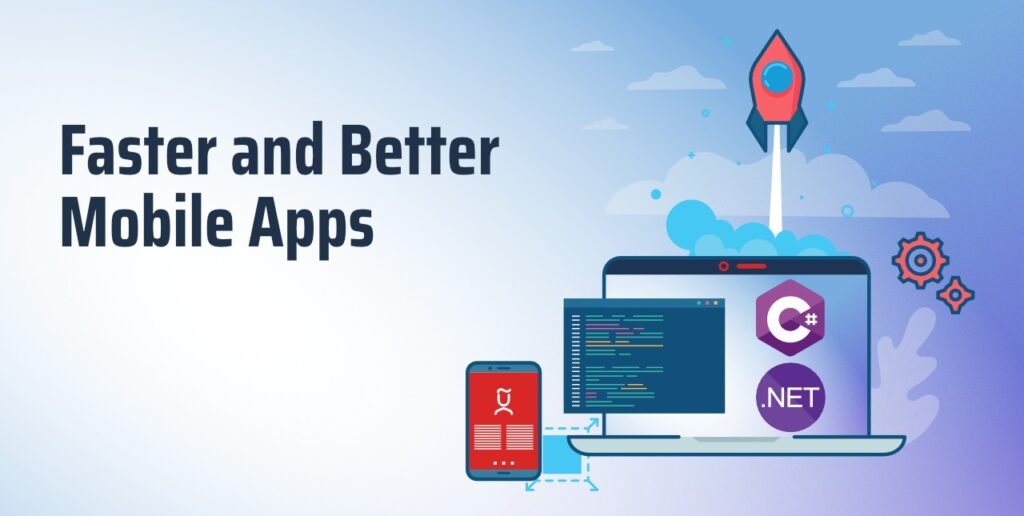Using C# and .NET for mobile apps is one of the most common choices among developers due to multiple reasons.
Close to “everyone” has a mobile phone, and most of them are smartphones. Do you know why they are called smartphones? It’s because they come pre-loaded with smart apps and have the flexibility in the hands of users to download apps for social media, gaming, banking, education, and whatnot. So, there are obvious reasons why organizations are looking towards mobile app development, and C# and .Net have become their go-to choices. However, developers need the right tools, frameworks, and strategies to build mobile apps faster and more efficiently, which we’ll discuss later in this blog.
C# is a versatile programming language used to create mobile apps, console apps, desktop apps, web services and apps, AI-powered apps, cloud-based solutions, IoT solutions, and reusable code libraries.
On the other hand, .NET is a software development platform that works seamlessly with various programming languages, including C#. Mobile app development on .Net is in high demand due to its simpler deployment, robust caching system, uniformity in handling processes, and enhanced developer productivity.
Let’s proceed to the core topic as you get the brief on C# and .Net.
In a dynamic business environment, scalability is crucial. IT services provide the flexibility to scale up or down your resources based on changing business needs. Cloud services, for instance, allow seamless expansion of storage and computational power

Serana Belluci
Product Designer
How To Develop Faster, and Better Mobile Apps with C# and .Net?

Both C# and .NET are popular among developers for building robust mobile apps.
Embrace Cross-Platform Development
Cross-platform means the developers write code once and deploy it across multiple platforms, saving time and effort. That increases the app development speed and efficiency. A good example is Xamarin, powered by Microsoft. This cross-platform framework leverages C# and .NET to build native iOS, Android, and Windows mobile apps.
So, when developers use Xamarin, C#, and .NET, they can share a significant portion of their codebase across different platforms. The development work is better aligned and reduces the need for platform-specific expertise. Additionally, Xamarin offers extensive support for native APIs and UI components. The result? The app works seamlessly on each platform.
Don’t Forget Utilizing Hot Reload Feature
Hot Reload is a feature available in Visual Studio and Visual Studio for Mac for developers to make real-time changes to their app’s code and see the results instantly.
They don’t need to rebuild the entire application to see changes. These hot reload features accelerate the development process as developers don’t get into the feedback loop.
Developers can iterate quickly on UI changes, layout adjustments, and code modifications.
When developers use Hot Reload during mobile app development on .Net, productivity and efficiency increase. Whether it’s tweaking UI elements, refining business logic, or debugging issues, Hot Reload provides a seamless development experience that accelerates the pace of mobile app development.
Integrate Backend Services with Cloud Like Microsoft Azure
Developers can use any reliable cloud service like Google Cloud, AWS, Digital Ocean, Oracle, Microsoft Azure, etc. However, developers should go for Microsoft’s cloud computing platform- Azure.
Azure offers many services and resources for faster mobile app development on .Net. Developers can leverage Azure services such as Azure App Service, Azure Functions, Azure Cosmos DB, and Azure Mobile Apps to build scalable, secure, and feature-rich backend infrastructure for their mobile apps.
Once the integration with cloud services is done, developers can offload backend tasks such as authentication, data storage, push notifications, and serverless computing.
By doing this, they can focus on building compelling front-end experiences. Additionally, Azure provides robust monitoring, analytics, and DevOps tools that streamline the deployment and management of mobile apps.
Make Use of Code Reusability and Modularization
Interoperability is a cornerstone of any object-oriented language, including C #’s architecture. Its ability to seamlessly function alongside codes written in the languages is phenomenal. This feature is precious for extending and enhancing the functionality of existing applications. There is no need to overhaul their foundation.
It shows C #’s flexibility and forward-thinking design, enabling collaboration and integration within the development process.
Availability of Extensive Libraries
C# and .NET developers should prioritize code reusability and modularization to build mobile apps faster and more easily. Developers streamline development by breaking down the app into smaller, reusable components and libraries.
Not only that, it facilitates collaboration and minimizes redundancy. Developers can use dependency injection, inversion of control, and SOLID principles to enhance code maintainability and scalability further.
Moreover, by employing automated testing frameworks like NUnit or MSTest, developers can validate their code quickly and ensure its reliability.
Choose Caching frequently Used Large Objects
In most cases, developers don’t need to worry about memory release or allocation because the .NET Core garbage collector does this automatically. Still, cleaning up unreferenced objects takes CPU time, and that hampers efficiency.
So, developers should minimize allocating objects. Additionally, dealing with garbage collection is burdensome when it involves hefty objects (exceeding 85 K bytes). Such substantial entities reside in the large object heap. That heap necessitates a comprehensive (generation 2) garbage collection process for their disposal.
The recurring cycle of allocating and freeing up significant space results in fluctuating performance levels. Hence, storing large objects temporarily mitigates the need for resource-intensive allocations.
This approach during mobile app development on .Net is suitable for keeping frequently used data from databases or external services, especially when slightly outdated information is permissible. So, depending on the circumstances, developers can choose a MemoryCache or a DistributedCache.
Enhancing performance through response caching is another effective strategy. It minimizes the number of inquiries sent to a web server by a client or proxy and lessens the server’s load in generating a reply.
Make Use of Xamarin.Forms for UI Development
Xamarin.Forms is a UI toolkit for developers to create native user interfaces through a single, shared codebase. With Xamarin.Forms, C#, and Mobile app development on .Net, developers can design intuitive and visually appealing UIs for their mobile apps. All they can do without having to write platform-specific code for each platform. By abstracting away, the complexities of platform-specific UI development, Xamarin.Forms facilitate developers to focus on features and functionality rather than worrying about UI inconsistencies across different devices. Not just that, Xamarin.Forms have a rich set of controls and layouts, support for data binding, and MVVM (Model-View-View-Model) architecture.
Conclusion
Without any doubt, C# and .Net will remain the driving force behind the app development. The way they were built, along with adaptation for the technical makes them a preferred choice for developers. The variety of tools, frameworks, and strategies for mobile app development on .Net, with the right team support, is the key to faster and better development. Once, the right approach and mindset are in place, mobile app development with C# and .NET is ALWAYS efficient and rewarding. What you need the most is the most talented team or a staff augmentation partner who can offer you, talented developers, at optimum pricing like Arna does it for its clients.



